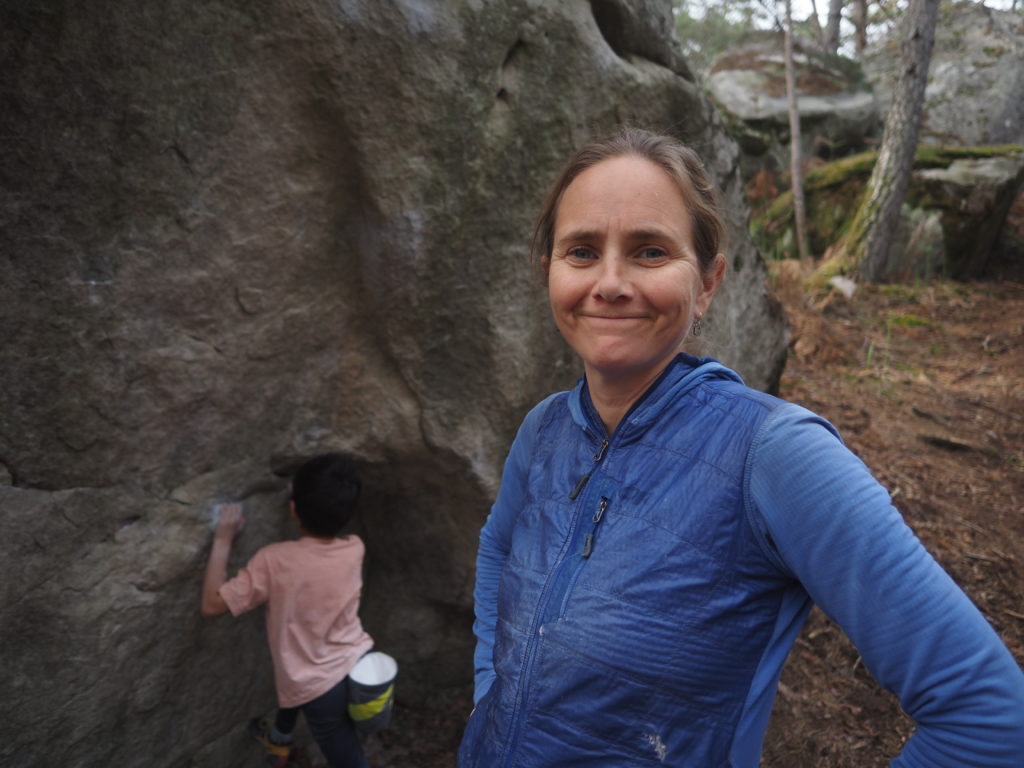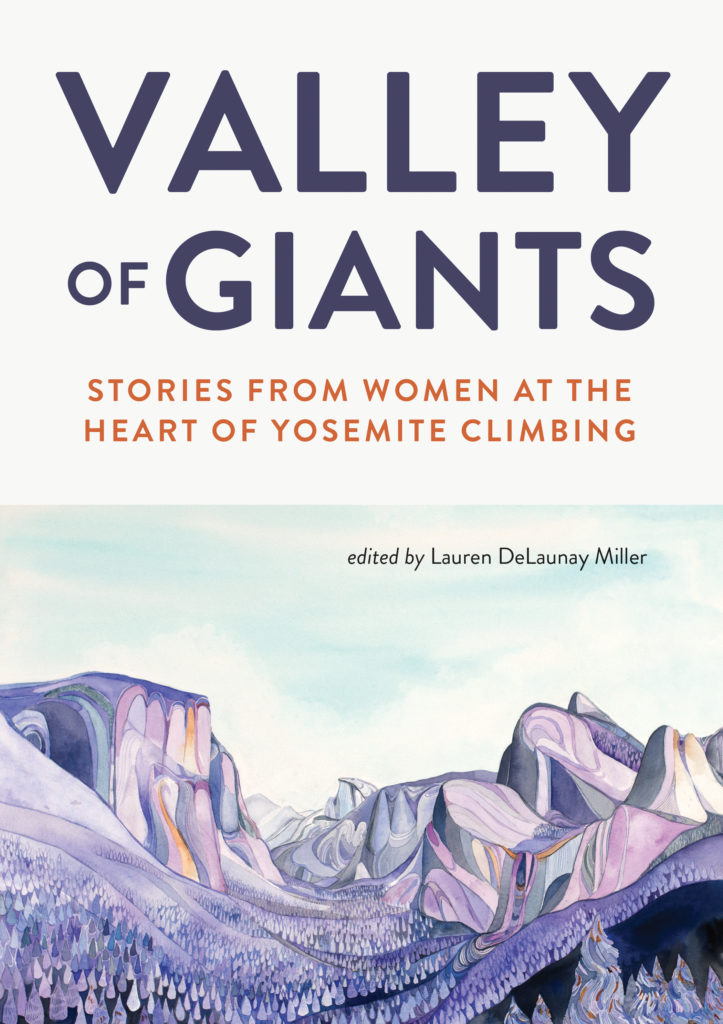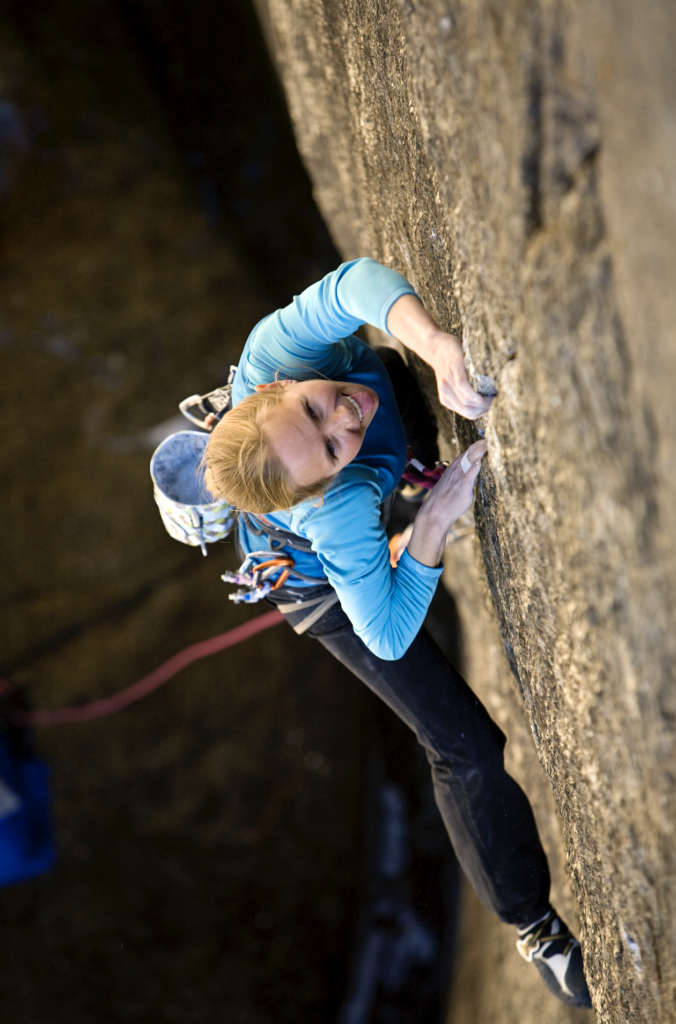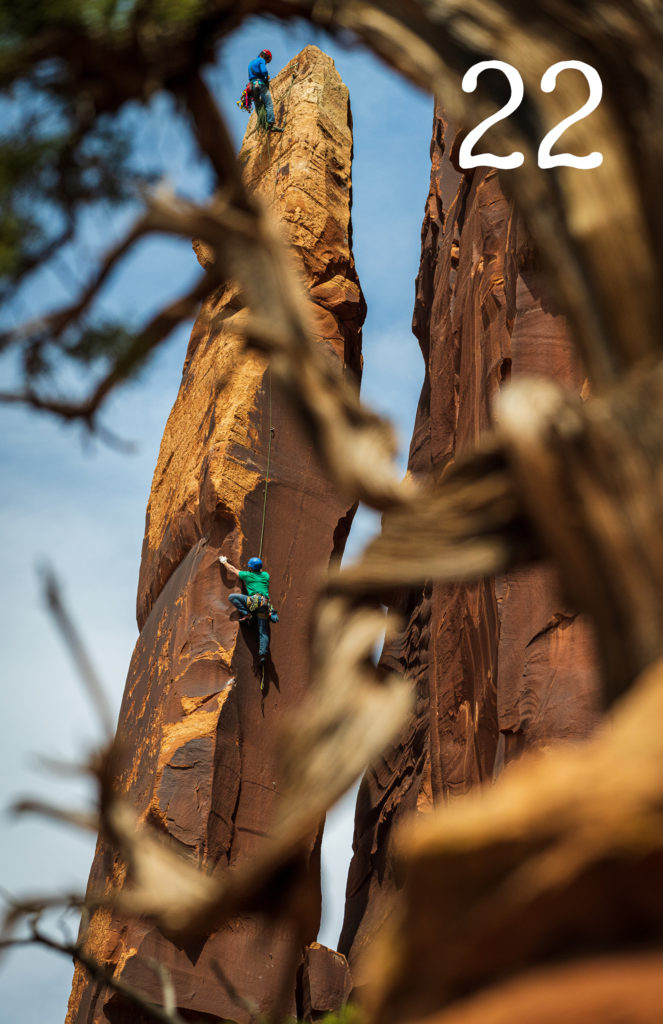Note from the editor of the Valley of Giants book, Lauren DeLaunay Miller:
A book about the women of Yosemite would not be complete without Beth Rodden. From teen comp phenom to freeing El Cap, Beth’s name was synonymous with hard climbing for over a decade. In many ways, her first ascent of Meltdown, one of the hardest single-pitch traditional climbs in the world, was the pinnacle of her climbing career. The word pinnacle often implies the top of an upward trajectory, and this certainly was true for Meltdown. A pinnacle is a peak, a summit; it is what we strive for.
But a pinnacle is also the beginning of a decline, and for Beth, the six-month process of establishing Meltdown also showed her that she needed to step away from climbing. The agonizing routine of attempting the route, then going home to train for hours, was harsh on Beth’s physical and emotional well-being. The route marked a turning point for her life both in and out of climbing and stands as a testament to what can happen, for better or for worse, when we devote ourselves entirely to the sport.
 This essay in published in Volume 22 of The Zine, now available
This essay in published in Volume 22 of The Zine, now available
Photos of the author by Corey Rich
This piece is also published in the new book: Valley of Giants: Stories of Women at The Heart of Yosemite Climbing, edited by Lauren DeLaunay Miller 
It’s always weird starting a new project, especially one that has never been done before, especially one left unfinished by one of my climbing heroes. So many questions run through my mind: Is it possible? Is it good? Is it worthy?
In September 2007, I started working on a thin, discontinuous crack through a dark-black wall next to Upper Cascade Falls in Yosemite. Ron Kauk had worked on it but had abandoned it many years earlier. The week before, I had surprised myself by completing a route of his, Peace, up in Tuolumne. Embarking on another one of his routes (this time unfinished) felt ominous but made me appreciate his eye for beauty and location in a climb.
I had spent the spring and fall of the previous eight years in Yosemite, slowly working my way up from After Six to El Cap, learning to trust the polished granite and convince myself that my swollen knuckles and bruised ego were all part of becoming a better Valley climber. At some point during that period, I realized I only had eyes for El Cap. I obsessed over free climbing in the vast amount of granite and endless possibilities. But after a handful of years up there and three free ascents, my body and mind were exhausted. I was tired of vertical manual labor. I wanted fresh food, a toilet that flushed, a refrigerator, and a fluffy pillow.
I had become that person who was a topic of shit talk around the cafeteria tables, but I didn’t care. I had paid my dues and experienced the fulfillment of free climbing the Nose and other routes. But more important, I knew what parts of me remained unfulfilled. At the time, I thought I just wanted a break. I convinced myself that shorter routes, ones I could walk to, ones where I could stand on the ground in between attempts, would be a worthy temporary substitute.
The route, which I would later name Meltdown, is striking. It’s directly to the right of Upper Cascade Falls. All of the rock within 20 feet of the ground is polished and pitch black, in stark contrast to the famous, sought-after white and light-gray granite of El Cap.
Some people can dive in and start putting together the pieces of a hard project right away, but I spend the first days and weeks just identifying the pieces, as if it were a giant jigsaw puzzle. Then, over the next months, I see if and how they come together. For Meltdown, this process took me six months.
Tommy Caldwell (my then husband) and I had just finished building our house in Yosemite a year earlier. Growing up in Davis, I had long had a love for the Sierra; our voracious love of climbing and obsession with Yosemite funneled us into wanting to make a home there. We had a rhythm of either trying a project together or alternating supporting each other on individual ones. Tommy had completed the first free ascent and then the first in-one-day ascent of Magic Mushroom on El Cap the previous spring, so this fall was mine.
I liked the somewhat-civilized nature of this project. We had spent the previous decade sleeping in our cars and vans, running from the rangers, poaching campsites—the typical rites of passage for anyone wanting to be called a Valley local in the early 2000s. But now I was settling into waking up in a warm bed, warming up on my home climbing wall in the garage, and driving to the project. It felt soft, but I secretly loved it.
By January 2008, I had found all the pieces and was stringing them together. I was making links from the bottom of the climb to the crux, and then from the crux to just before the anchor, and then to the anchor. My progression was steady, which gave me faith that I would be able to do it. The skin on the sides of my knuckles was raw from the sharp and precarious finger locks, and I wore through shoes every other week from standing on incredibly precise footholds. But for the most part, it was a progression that kept me coming back, that fed my desire to set loftier and loftier goals. I pushed my body to exhaustion each day on the route and then returned home and trained for another three hours. I thought that by pushing my limits I could extend the sport of climbing into uncharted territory. It felt oddly virtuous at the time, even though when I think about it now, it seems so inconsequential to climb a 70-foot piece of rock for the first time.
This was our first full winter in Yosemite (except for the one when we built our house, when we didn’t climb at all), and at that time, the Sierra got consistent, massive snowstorms. It snowed a typical four feet in this storm, and two days later we were hiking up to see how many more days I needed to let pass before I could try the route again. As we walked up the river wash, carefully balancing on one slick boulder after another, my face became wet with spray about 50 feet earlier than any other day we had hiked up there. As we continued up, my face got wetter and wetter and my spirits lower and lower. When it warmed up after each snowstorm, the waterfall grew and grew, making the climb wetter and wetter.
For someone who hung most of her identity and self-worth on making each climbing objective harder, the thought of nature putting a stop to all my hard work of the past five months felt unjust. I felt tears welling in my eyes, my face became hot, and my hands started sweating. I looked up at the climb, and the entire bottom half was glistening. Spray was engulfing at least 20 feet of the thin crack all the way to the crux. My heart sank. Was this the end? Did I have to pack up and wait until next October? Would I forget everything? Could I ever get back to where I was? I knew the route like the back of my hand. I could practically mime the sequence in my sleep. I loved how fit I had become. I loved the precision of my hands going into the crack, knowing how hard to flex and turn; I loved how decisive my feet had become in each placement, sticking to improbable minuscule polished bumps. The thought of leaving all that alone for the next nine months felt devastating.
I looked at Tommy. “How many days? Can we put up a tarp? Should we let our cars idle for the next week to promote climate change so it will never snow again?” My brain just dumped all my fears and irrational thoughts out of my mouth.
Forever the optimist, Tommy said, “Let’s come back in a few days. You are so close; you can do this.” We turned around and walked back to our truck, where we could continue listening to Harry Potter on tape, my one escape from obsessing over this climb.
For the next months, I made slow progress, at first hanging three times on the route, then twice, and then just once. Each time gave me a little more hope. After my work on the route each day, I would train until I couldn’t lift my arms above my head. But each big snowstorm brought a meltdown of fear that I wouldn’t be able to do the route before spring came.
On Valentine’s Day 2008, I was getting to the point where I was over it. That may sound funny since my obsession was with a random 70-foot crack on an arbitrary wall in Yosemite. When you really think about it, climbing is altogether pointless, but when you’re so deep into it, when it’s your professional life and your personal life and your identity, it seems crucially important. I was getting tired. I was burned out and wanted to take a break. I wanted not to have to worry about what I ate each day, the size of my waist, if my skin was good, if my shoes were perfectly broken in but not worn out. I knew I could do the route. I was strong enough, I was fitter than I’d ever been, and it was the hardest thing I had ever tried.
On that day, I got to the base and felt a light spray on my face. The waterfall was slightly bigger than the week before. It was slightly warmer, which meant a little more snow from the high country was melting and draining out through Upper Cascade Falls. Each warmer day, the waterfall would get bigger and bigger. I felt a sense of urgency, but somewhere inside I squashed it with a rare feeling of confidence. I put on my shoes, pulling them tight and placing the Velcro perfectly. I cinched my harness and clipped on my gear in precise order. I put my hands in my chalk bag and looked up at the route. I knew it. I knew what to do. I knew how hard to try. The waterfall was loud, but I could hear my thoughts. Just fucking get this done, I said to myself. I put my hands in the crack and started up.
Climbing my hardest for me is a balance between listening to the thoughts in my head that I need to and filtering out the ones I don’t. When I listen to the chatter, the worry, the doubt, the questioning, that’s when I get distracted. But filtering these out is not some Zen moment where I don’t hear anything. I talk to myself the whole time, my mind racing through the information I’ve learned over the past six months, all of the smallest details: how hard to clench my abs, how much to turn my finger, when to breathe, where to put my gear in, how to check it, how many times to shake out. It’s a constant track in my head, sometimes on loop like breathing and relaxing, sometimes specific like tighten your abs, twist here, crimp but not too hard there.
Getting through the crux surprised me, but I didn’t let that emotion distract me. I knew there were still hard parts, that I was tired, that I still needed to keep my attention on the climb, not what I had just accomplished. I could hear Tommy below, but I didn’t let my attention go enough to hear what he was saying. Another 30 feet of climbing and I clipped the anchors. I slunk onto the rope and immediately felt relief. I felt lighter; I felt proud; I felt lost and found all at the same time. It was a huge endorphin rush.
We celebrated the only way we knew how, at the hot-food bar of Whole Foods in Fresno after a two-hour training session in the garage.
It’s been more than a decade since I completed Meltdown—a route that was not repeated by anyone until November 2018—and since I last climbed El Cap.
Tommy and I divorced; I fell in love and remarried and started a family with the birth of our son. Meltdown was the pinnacle of my accomplishments in climbing. It was the culmination of fifteen years of wanting to push myself and the sport of climbing forward. But on the other side of Meltdown, I realized, slowly, that pushing climbing forward couldn’t fill all the gaps and holes in my life, that accomplishment and achievement were not the only ways to happiness. I had achieved more than I could dream of, but there was still something missing and an underlying unhappiness that I couldn’t get rid of. I started to notice that with each climb I did, with each cover I was on, with each video I was in, I only felt pressure to do more and bigger and better. It was time to stop.
I still live in Yosemite, but my life here looks quite different from before. Our son goes to school in the Valley, and his friends are the kids of rangers, the same group of people I used to hide and run from when I was in my twenties.
I now spend most of my climbing days on the boulders below the cliffs I used to climb. Occasionally we’ll venture up on a route where I remember the unique feeling of the wind and sun and birds on the wall.
Sometimes I miss the simplicity of sleeping and camping in a van. But we’ve been able to turn this magical valley into our home, into a way of life for our little family. I love going on hikes and climbs with my husband and son that I would have scoffed at in my younger days. After Six, a five-pitch 5.7, is now my favorite climb on Earth. If I could do only one climb for the rest of my life, it would be that.
Beth Rodden started climbing in a gym in Davis, California, at the age of fourteen, and by the time she graduated from high school, she was traveling the world for climbing competitions. She left college after just one semester to follow her passion for the mountains. In the following years, Beth would make three free ascents of El Capitan, including the first free ascent of Lurking Fear; be held hostage for six days by militants on a big-wall climbing trip to Kyrgyzstan; and establish what was Yosemite’s hardest single-pitch climb (5.14c) at the time, Meltdown. She then stepped away from the climbing spotlight to focus on balance, healing, and family.
She lives with her husband and son in Yosemite, where they can climb, play, and bask in the beauty of the natural world.
This essay was originally published in the new book Valley of Giants: Stories from Women at the Heart of Yosemite Climbing. The book is edited by Lauren DeLaunay Miller and published by Mountaineers Books.
Volume 22 of The Zine is now available.



 Volume 22 of The Zine is now available.
Volume 22 of The Zine is now available. 




